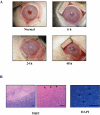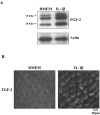Induction of FGF-2 synthesis by IL-1beta in aqueous humor through P13-kinase and p38 in rabbit corneal endothelium
- PMID: 19797202
- PMCID: PMC2822434
- DOI: 10.1167/iovs.09-4240
Induction of FGF-2 synthesis by IL-1beta in aqueous humor through P13-kinase and p38 in rabbit corneal endothelium
Abstract
Purpose: To determine whether the elevated level of interleukin (IL)-1beta in aqueous humor after transcorneal freezing upregulates FGF-2 synthesis in rabbit corneal endothelium through PI3-kinase and p38 pathways.
Methods: Transcorneal freezing was performed in New Zealand White rabbits to induce an injury-mediated inflammation. The concentration of IL-1beta was measured, and the expression of FGF-2, p38, and Akt underwent Western blot analysis. Intracellular location of FGF-2 and actin cytoskeleton was determined by immunofluorescence staining.
Results: Massive infiltration of polymorphonuclear leukocytes (PMNs) to the corneal endothelium was observed after freezing, and IL-1beta concentration in the aqueous humor was elevated in a time-dependent manner after freezing. Similarly, FGF-2 expression was increased in a time-dependent manner. When corneal endothelium was stained with anti-FGF-2 antibody, the nuclear location of FGF-2 was observed primarily in the cornea after cryotreatment, whereas FGF-2 in normal corneal endothelium was localized at the plasma membrane. Treatment of the ex vivo corneal tissue with IL-1beta upregulated FGF-2 and facilitated its nuclear location in corneal endothelium. Transcorneal freezing disrupted the actin cytoskeleton at the cortex, and cell shapes were altered from cobblestone morphology to irregular shape. Topical treatment with LY294002 and SB203580 on the cornea after cryotreatment blocked the phosphorylation of Akt and p38, respectively, in the corneal endothelium. These inhibitors also reduced FGF-2 levels and partially blocked morphologic changes after freezing.
Conclusions: These data suggest that after transcorneal freezing, IL-1beta released by PMNs into the aqueous humor stimulates FGF-2 synthesis in corneal endothelium via PI3-kinase and p38.
Figures







References
-
- Fuchs E. On keratoplasty. Z Augenheilkd 1901; 5: 1–5
-
- Rodrigues MM, Waring GO, Laibson PR, Weinreb S. Endothelial alterations in congenital corneal dystrophies. Am J Ophthalmol 1975; 80: 678–689 - PubMed
-
- Waring GO, Laibson PR, Rodrigues M. Clinical and pathologic alterations of Descemet's membrane: with emphasis on endothelial metaplasia. Surv Ophthalmol 1974; 18: 325–331
-
- Kay EP, Smith RE, Nimni ME. Type I collagen synthesis by corneal endothelial cells modulated by polymorphonuclear leukocytes. J Biol Chem 1985; 260: 5139–5149 - PubMed
Publication types
MeSH terms
Substances
Grants and funding
LinkOut - more resources
Full Text Sources
Other Literature Sources

